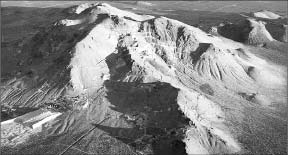Golden Queen Mining (GQM-T) is looking to prove that there is still plenty of gold in California, albeit at a much lower grade than what the ’49ers were used to.
The company filed an updated feasibility study on its Soledad Mountain project in southern California’s Kern Cty., showing the large tonnage, low-grade deposit could have what it takes to generate positive returns for investors, provided metal prices remain at historic highs.
And the market seems impressed. As recently as May 12 the company’s shares traded at $2.98, but in Toronto on May 18 – one day after the report was filed – they closed 24% higher at $3.69.
The completion of the study comes after major approvals and permits were secured last year. Water and discharge plans were approved last July.
The feasibility study envisions an open-pit, heap-leach mine built for US$88.9 million. That number, however, does not include lease financing of the mining equipment, which is a significant added cost.
That capital outlay provides Golden Queen shareholders with a low-cost producer once silver credits are accounted for. The project is expected to produce gold at a cash cost of just US$133 per oz.
This eye-catching number, however, was calculated with high metal prices. Metal prices in the study were US$1,457 per oz. gold and US$39.63 per oz. silver.
Those aggressive numbers fly in the face of the best-practice rule of conservatism. It should come as little surprise when they generate gaudy numbers in a discounted cash flow analysis.
The net present value (NPV) for the project came in at US$722 million using an 8.0% discount rate, but this is calculated with the high silver and gold prices.
Golden Queen also released information on the effect of lower metal prices. The study showed that a 10% drop in metal prices lowers the NPV by US$143 million, to US$579 million.
But a 10% drop does not bring the company closer to conservative numbers. A relevant metric to employ in the NPV calculation is the 36-month average of gold and silver prices. When this average is factored, the NPV falls to US$343 million.
Golden Queen requires significant amounts of financing to fuel the project into production. The company says it will secure this financing if gold and silver prices remain near the high levels used in its NPV calculations.
If the mine is constructed, it would target production rates of 75,000 oz. gold and 950,000 oz. silver per year, with a total of 936,332 oz. gold and 10.4 million oz silver produced over the mine’s 13-year life.
The project currently has measured and indicated resources of 90.4 million tonnes grading 0.744 gram gold per tonne and 0.35 gram silver per tonne, for 2.2 million oz. gold and 37.6 million oz. silver. Another 32 million tonnes at 0.49 gram gold and 0.32 gram silver lie in the inferred category.
The strip ratio in the feasibility study was a low 1.85-for-1.
The company launched an infill drill program in April, with assay results due soon.
The program put nine holes into the North-West open pit, which is projected as the first location for mining. Another 11 holes were drilled in the area of the East open pit, with an eye toward upgrading inferred resources to the reserve category.
High-tonnage, low-grade mines work best in areas that are well-developed, because existing infrastructure is a key component to keeping costs down. On that front, Soledad is in a sound position. The project is situated near the town of Mojave, which is accessible by state highway.


Be the first to comment on "Golden Queen relies on high metal prices to generate impressive NPV"